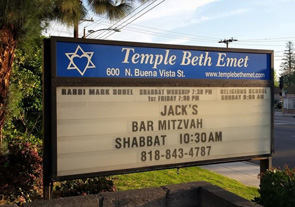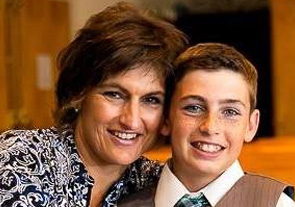PRESIDENT’S MESSAGE – April 2024
Recently Diane and I attended a concert at the Soraya, the performing arts center at CSU Northridge. If you haven’t been there, I strongly recommend you check out its offerings. It is a magnificent building inside and out, and a real gem of the San Fernando Valley.
Diane is a member of the CSUN’s Association of Retired Faculty and its members were invited to attend a reception and concert honoring former CSUN President, Jolene Koester, who was instrumental in getting the Soraya built. The concert was a performance of the Academy of St. Martin in the Fields, with its director Joshua Bell as violin soloist. It was a wonderful concert and the audience was very appreciative. We’ve seen Joshua Bell several times at the Hollywood Bowl as part of our Temple Summer Concert Series and the Academy of St. Martin in the Fields has been part of our own music collection for many years.
One of the pieces featured in the concert was a favorite of mine, Mendelssohn’s Violin Concerto in E Minor. I’ve been listening to it all my life. My father would play a record with Isaac Stern as soloist and I pretty much know each note, each beat — including the skip on the record at some point near the beginning. I have it on CD, and while it doesn’t have the skip it is special to me nonetheless.
The Concerto is well-known as a test of the violinist’s skill, and there is a particular passage that is incredibly complex and difficult. It is one of those how-do-they-even-play-that passages. When we saw Joshua Bell at the Bowl he had indicated he was going to depart from the original composition and substitute this particular passage for one of his own construction. His was admittedly brilliant, a requisite display of dexterity by a master of his instrument and craft. But it wasn’t right. He did the same at the Soraya without explanation. It still wasn’t right, and when we got home I pulled out Isaac Stern and rinsed my ears out with the correct version.
Often the way we learned something stays with us as the only, or at least the best way to do something. The way we conduct our religious services, for example. I like to say that we train our Bnei Mitzvah students so well they can walk into any Jewish congregation and know that the way the congregation is doing the service isn’t right. Jewish prayer melodies, even within congregations that are all Orthodox, Conservative, or Reform, can vary. Sometimes slightly, such as a where a sentence is broken or if the voice raises or lowers, sometimes significantly. But usually the result is harmonization rather than dissonance.
Even the way we celebrate Passover or conduct a Seder can vary from family to family. For some of us the Seder According to Maxwell House is the one true version. In my family my father often declared that anything after the meal was optional, except maybe the remaining glasses of wine. Our friends we visit for Seder have a more modern Haggadah, with additional points for discussion in the margins. There are many variations and adaptations of the Haggadah, as the Seder is traditionally a family home celebration. Different families have different traditions and needs. Type “Haggadah” in the Amazon search bar and it returns over 1,000 results!
The point is, whatever version of any interpretive work you encounter, you should try to take something positive from it. You should find joy and meaning in it. You should try to learn something from it. You should enjoy the sharing of it with those around you. Even if you know in your heart it isn’t right.
Chag Pesach Sameach, Happy Passover to you and yours, no matter which Haggadah you encounter!
— IRA L. GOLDSTEIN, President




